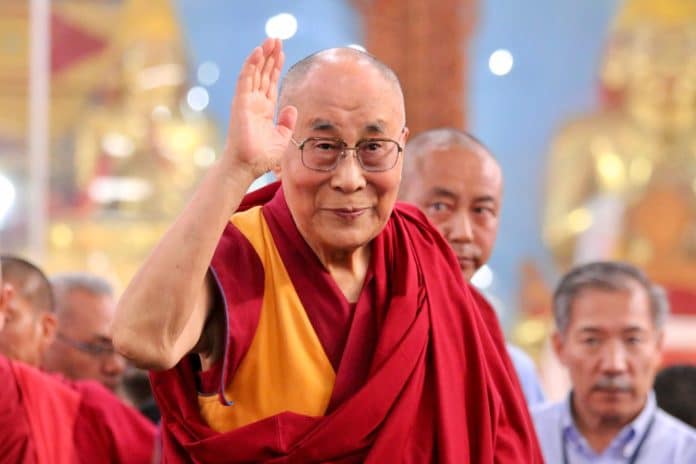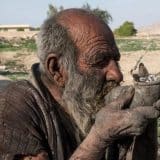It was the 40th year of Kangxi’s reign or 1701 A.D., a Tibetan letter was sent from Lhasa to Beijing.
“Your Majesty the Great Emperor:
Please recognize His Holiness Tsangyang Gyatso as the Sixth Dalai Lama enthroned by Desi Sangye Gyatso. And please also bestow him the Tibetan-Chinese golden certificate and stamp as for the previous Fifth Dalai Lama.” – writes Roland Delcourt.
It was a turbulent era on the Tibetan plateau. During the previous decade, Desi Sangye Gyatso ostensibly obeyed the Qing Court but secretly partnered with the Qing Dynasty’s strongest enemy; Galdan Boshugtu Khan, leader of the Dzungar Mongols. Galdan Boshugtu Khan was defeated by the Kangxi Emperor and died four years earlier in 1697, leaving Desi Sangye Gyatso and the young Tsangyang Gyatso in an awkward position. The above begging letter was rejected and Tsangyang Gyatso reused the stamp bestowed upon the Fifth Dalai Lama.
The story didn’t end here, the Dzungar Khanate Mongols continued their expansion towards Lhasa after Galdan Boshugtu Khan’s death. A Dzungar Khanate general overthrew Lha-bzang Khan and again forced Yeshe Gyatso to abdicate. This time, both Dzungar Khanate Mongols and Qinghai Mongols worshipped a Litang boy, Kelzang Gyatso, believing he was the reincarnation of Tsangyang Gyatso.
However, the Qing court promptly reacted and put Kelzang Gyatso under their protection. The Qing Court launched a large joint campaign with the Qinghai Mongolian army and their own forces. The expedition was launched to recover the Dalai Lama’s throne in Lhasa, with Kelzang Gyatso himself participating in the campaign. The Dzungar Khanate Mongols were driven out of Tibet and Kelzang Gyatso was enthroned as the new Dalai Lama in Potala. Because the Qing Court did not approve of Tsangyang Gyatso, the new certificate only regarded Kelzang Gyatso as the Sixth Dalai Lama, the third one with the title (As late as 1780, the Qianlong Emperor recognized Kelzang Gyatso’s reincarnation as the Eighth Dalai Lama, implying Kelzang Gyatso was, in fact, the Seventh Dalai Lama).
The complicated story of the three different Sixth Dalai Lamas vividly shows the destiny of the Lamas’ implications in various political struggles. Political power played the upper hand while religious guidance was set aside. The Qing Court understood the significance of the Dalai Lama in Tibetan and Mongolian politics, it was therefore vital to securing tight control over the Gelugpa School as well as the Dalai Lamas. This has been the core principle of the Qing policy. At the beginning of Kelzang Gyatso’s era, the Dalai Lama was more of a religious figure and the power of administration lay in the hand of a secular Tibetan noble family. In 1751, the Qianlong Emperor set up Tibet’s theocracy system with the Dalai Lama as both a secular and religious ruler. In 1793, the Qing Court issued the Twenty-Nine Articles on the Aftermath of Tibetan Affairs, in which the Golden Urn was introduced to decide the selection of high-level Tibetan and Mongolian Lamas including the Dalai Lama.
Since its birth, the Dalai Lama has never been a purely religious figure. As the leading Lama in Tibet and its influential surrounding areas, several political leaders tried to secure the Lama to serve their own political agenda. The great Lamas, just like many other religious leaders, learned how to serve the political power and leverage their sponsorship for the best religious interest (Tibetan Buddhism calls it Cho-yon). However, several Dalai Lamas, often short-lived, became the puppets of powerful Tibetan noble families.
We might be surprised by the interference of a secular government in seemingly pure spiritual affairs, this however is not cultural exceptionalism. The King of England, Henry the Eighth, would have agreed on one of China’s government’s core policies on religion, which is to refuse and expel foreign influence, especially influence with political implications. In European medieval history, power struggles between monarchies and the church were fierce and often bloody. As Europe modernised, Western society gradually separated the state and the church as the saying: “Give Caesar what belongs to Caesar, give God what belongs to God”. In the case of Tibet, the theocratic system outlasted the Qing Dynasty and survived until 1959. This rich tradition means the Lamas still play an active role in secular life and politics. In a similar case to the Qing Court, having an untrusted high-level Lama is harmful to the rule and order of China. Although the Chinese government doesn’t really care who exactly is the true reincarnation of the Dalai Lamas, it would be improper but especially naïve to suggest it had no say in the matter.
The current reincarnation process was not invented by the Chinese Communist Party. As Tibet is part of China’s territory, any high-level lama in Tibet must be recognised and obtain the blessing of the government. The current situation of Lamas exiled in India has a complicated historical background, however, a brand-new foreign Lama with great influence over part of China is just too absurd and unimaginable for any Chinese government. From an observer’s perspective, it is in the best interest of China and the Dalai Lama to get a certain tacit agreement on the reincarnation process, which might be an opportunity to solve the Tibetan issue once and for all. Unfortunately, due to past problems, especially the catastrophic end of the Panchen Lama’s reincarnation, there is little trust between both sides and such an agreement would be extremely difficult. Tenzin Gyatso, the current Fourteenth Dalai Lama needs to carefully think about the legacy he wishes to leave for Tibet.
Compared with the Qing Dynasty’s actions toward Tibetan Buddhism, the Chinese Communist Party is in fact much more moderate. Unlike the Qing Court in 1904 and 1910, the Chinese Government did not deprive Tenzin Gyatso of his Fourteenth Dalai Lama title after his exile in 1959. When China entered a new era of reform in the 1980s, the government corrected its past policy in Tibet and funded Buddhist monasteries with monetary help from the local and central governments. Even when facing rebellious Tibetan monks in the 1990s and beyond, the Chinese government never went as far as the Qing Court to close or totally remove them.
With possibly the world’s longest secular system, today’s China is still evolving its own principle of separation from the church and the state. Throughout history, the Tibetan Lamas always tried to find political sponsors to expand their religious sphere of influence. Today, the Tibetan Lamas need to leave the political and secular domain to refocus on the religious domain, at the same time, the secular government should adapt its laws to regulate religious activities and gradually reduce its roles in religious affairs.














